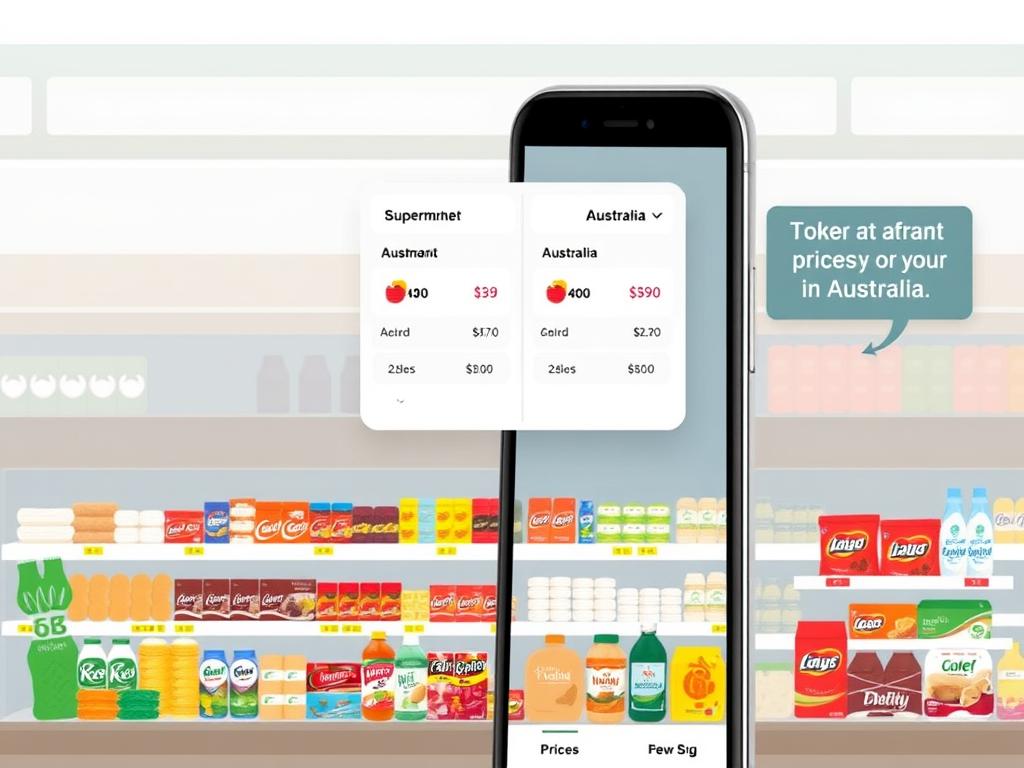The rising cost of living in Australia has made it challenging for households to manage their expenses effectively. With grocery prices increasing significantly, it’s essential to get clever about your weekly food budget.
Did you know that the average grocery spend per household is around $185 per week for one person, $280 for a couple, and $400+ for a family of four? These figures can be daunting, but with a well-structured shopping budget, you can take control of your finances and reduce financial stress.
By understanding your current spending habits and creating a realistic budget, you can save money without sacrificing quality or the items you love. Tools like Wispri’s price tracking platform can help you stay on track by monitoring product prices across multiple retailers and sending instant alerts when prices drop.
Key Takeaways
- Create a realistic budget that suits your lifestyle
- Understand your current spending habits to make informed decisions
- Utilize price tracking tools to save money on groceries and everyday purchases
- Reduce financial stress by managing your household expenses effectively
- Maintain your budget long-term with regular monitoring and adjustments
Why Most Shopping Budgets Fail
Many households struggle with grocery budgets that are not based on actual spending habits. Creating a realistic budget requires understanding the factors that affect grocery costs.
Common Budget Pitfalls
A key reason grocery budgets fail is due to common pitfalls that households fall into. For instance, not accounting for regional price variations can lead to unrealistic budget expectations. Australian households are facing increasing pressure on their grocery budgets, with food prices rising significantly faster than wages in recent years.
- The average Australian family spends between $250-$400 per week on groceries.
- Regional price variations mean identical grocery items can cost up to 40% more in remote areas.
- Hidden costs, such as transport and food waste, add to the annual food budget.
The Real Cost of Grocery Shopping in Australia
According to Finder, the average grocery spend per household is around $185 per week for one person, $280 for a couple, and $400+ for a family of four. The cost of living in a particular area significantly impacts the family’s grocery budget. For example, families in major cities tend to spend more on groceries than those in regional areas.

Understanding the real cost of groceries helps create realistic expectations for your shopping budget. Seasonal variations in fresh produce prices can significantly impact weekly food costs.
Creating Your Smart Shopping Budget Framework
To shop smartly, you need a budget that is both realistic and flexible. This involves understanding your spending habits, setting realistic limits, and making adjustments as needed. A smart shopping budget is not just about cutting costs; it’s about making informed decisions that align with your financial goals.
Determining Your Realistic Spending Limit
The first step in creating your smart shopping budget is to determine your realistic spending limit. This involves assessing your income and expenses to identify how much you can afford to spend on groceries and other shopping items each week. Consider using tools like Wispri’s AI-powered price monitoring to help you track prices and make the most of your budget.

Tracking Your Current Spending Habits
To create an effective budget, you need to understand your current spending habits. Track your expenses over a few weeks to identify patterns and areas where you can cut back. This will help you allocate your budget more efficiently and make informed decisions about your spending.
Setting Category-Specific Allocations
Divide your budget into categories such as grocery, dining out, and takeaway foods. Allocate specific amounts to each category based on your spending habits and financial goals. This will help you stay on track and ensure that you’re not overspending in any one area.
Building Flexibility Into Your Budget
A rigid budget is destined to fail. To avoid this, build flexibility into your budget by including a small “buffer” amount for unexpected expenses or opportunities. Consider implementing a “rollover” system where unspent money from one category can be saved or moved to another category the following week. This encourages mindful spending and helps you adapt to changing circumstances.
- Build in a small “buffer” amount (around 5-10% of your total budget) for unexpected expenses or opportunities.
- Create a “rollover” system where unspent money from one category can be saved or moved to another category the following week.
- Incorporate seasonal flexibility into your budget to take advantage of seasonal produce and sales.
Money-Saving Strategies for Your Shopping Budget
Smart shoppers know that saving money requires more than just cutting costs – it demands a strategic approach. By implementing the right strategies, you can significantly reduce your expenses without compromising on the quality of your shopping.
Meal Planning to Reduce Food Waste
One effective way to save money is by planning your meals in advance. This helps in creating a more accurate grocery list, reducing the likelihood of buying unnecessary items and subsequently reducing food waste. By knowing what you will cook, you can also take advantage of bulk purchases and seasonal produce.
Strategic Store Selection and Price Comparison
Comparing prices across different stores is crucial for saving money. In Australia, supermarkets like Coles and Woolworths often have different prices for the same item. Using price comparison tools or apps can help you identify where to shop to get the best deals.

Bulk Buying and Seasonal Shopping
Buying in bulk and shopping seasonally can lead to significant savings. Non-perishable items can be bought in bulk and stored for future use, while seasonal produce is often cheaper and fresher. This strategy requires some planning but can be very rewarding.
Store Brands vs. Name Brands: Making Smart Choices
Opting for store-brand items instead of name-brand products can lead to substantial savings. Often, the difference between store-brand and name-brand products is just the packaging, with similar quality. For instance, a store-brand can of tomato soup might cost $1, while a popular brand could cost $2.
Using Wispri to Track Price Drops
Wispri is Australia’s leading price tracking platform that helps smart shoppers save money by monitoring product prices across multiple retailers. With features like AI-powered price monitoring and customizable price drop alerts, you can time your purchases perfectly and avoid paying premium prices.
Wispri tracks prices from major Australian retailers, including Amazon Australia, eBay, JB Hi-Fi, Harvey Norman, Officeworks, and Bunnings. By using Wispri, you can save an average of 15-30% on major purchases.
![]()
By incorporating these strategies into your shopping routine, you can significantly reduce your expenses and make the most out of your budget. Whether it’s meal planning, comparing prices, or using a price tracking platform like Wispri, every little bit counts towards achieving your savings goals.
Maintaining Your Budget Long-Term
Maintaining a shopping budget over the long term is a journey that requires patience, discipline, and the right strategies. To achieve financial stability, it’s crucial to buildsustainable habitsrather than relying on short-term motivation. Regular budget reviews, ideally monthly, help you adjust allocations based on changing needs and seasonal variations.
Creating accountability systems, such as budget tracking apps or regular check-ins with a partner, significantly increases long-term budget success. Celebrating budget wins and acknowledging progress, no matter how small, helps maintain motivation and reinforces positive financial behaviors.
Automating aspects of your budget through scheduled transfers and price tracking alerts reduces the mental load of constant budget monitoring. Building occasional rewards into your budget prevents the feeling of deprivation that often leads to budget abandonment. Using tools like Wispri to time your purchases for maximum savings helps stretch your budget further.
Developing a positive mindset around budgeting transforms it from a chore into an empowering practice. Sharing money-saving discoveries and budget successes with friends and family can create a supportive community that reinforces good habits. With MyBudget managing your finances, you’ll always know exactly where your money is going, making it easier to save on groceries and stay on budget.
By following these strategies and maintaining a commitment to your financial goals, you can achieve long-term success with your shopping budget.
FAQ
How can I determine a realistic spending limit for my household?
To determine a realistic spending limit, track your current spending habits over a few weeks to understand where your money is going. Consider your income, expenses, and financial goals to set a weekly grocery budget that works for you.
What are some effective ways to reduce food waste and save money?
Meal planning is a great way to reduce food waste. Plan your meals around the ingredients you already have at home, and make a grocery list to avoid buying unnecessary items. You can also use up leftovers in creative ways, such as turning last night’s dinner into tomorrow’s lunch.
Are store brands really worth buying instead of name brands?
In many cases, yes! Store brands, such as Woolworths’ Woolworths Essentials or Coles’ Coles Smart Buy, offer similar quality to name brands at a lower price point. Consider buying store brands for non-perishable items, such as canned goods or pasta, to save money.
How can I stay on top of price drops and discounts?
What’s the best way to allocate my grocery budget across different categories?
A general rule of thumb is to allocate 50% of your grocery budget towards fresh produce, meat, and dairy products, 30% towards pantry staples, and 20% towards household essentials and treats. However, this may vary depending on your personal preferences and dietary needs.
How often should I review and adjust my shopping budget?
It’s a good idea to review your shopping budget regularly, such as every few months, to ensure you’re on track with your financial goals. Adjust your budget as needed to reflect changes in your income, expenses, or lifestyle.

